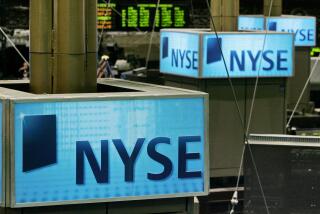Soft-Landing Fans Wake Up to Hard Facts of Slowdown
- Share via
With each new economic report, it’s clear that U.S. business activity is slowing much faster than most people expected.
Which raises a very painful question for Wall Street: How can corporate earnings stay high enough to support record stock prices if demand for goods and services is plummeting?
The market may have been reacting partly to those worries on Thursday as shares of industrial firms most sensitive to the economy’s swings led the Dow average down 25.93 points to 4,412.23.
Until now, investors’ belief in the soothingly nebulous idea of a “soft landing” has largely fueled stocks’ 1995 rally. A moderately growing economy would keep interest rates subdued while allowing corporate earnings to continue advancing.
But this week, the government shocked many soft-landing fans with a report that April durable-goods orders took their biggest drop in 3 1/2 years. And on Thursday, the National Assn. of Realtors said April sales of existing homes sank 6.4% despite lower mortgage rates.
Even allowing for the usual caveat that monthly statistics can be volatile and misleading, most Wall Street pros concede that the economy is decelerating rapidly. What started with slumping auto and home sales earlier this year is spreading, says Lacy Hunt, chief economist at HSBC Securities in New York. “Weakness in one sector feeds on other sectors,” he says. “The slowdown becomes self-reinforcing.”
*
That was the Federal Reserve Board’s plan, of course, as the central bank jacked up interest rates last year. But for investors, the issue now is: How slow an economy is too slow to maintain the kind of corporate profit growth that a sky-high stock market needs to stay sky high?
Even without the latest barrage of alarmingly weak data, hopes that second-quarter earnings gains could match first-quarter gains were probably misplaced.
While consumer spending began to slide in the first quarter, many companies were still enjoying pent-up demand filling orders to restock inventories. What’s more, spending by businesses on capital equipment--machinery, computers, etc.--continued to rocket, part of a powerful recent trend toward enhanced corporate productivity.
Non-residential fixed-investment spending, the Commerce Department’s main gauge of capital spending, rose a stunning 19.3% in the first quarter of this year from the fourth quarter of 1994. And the fourth quarter was up 17.6% from the third.
No wonder that operating earnings of Standard & Poor’s roster of 500 blue-chip companies rose 24% in the first quarter versus a year earlier, led by gains at industrial firms.
But as economic weakness spreads, can capital spending stay at such high levels? Many experts doubt it. “We can’t continue to expect that the [first-quarter] pace is sustained,” says Stan Nabi, strategist at Bessemer Trust in New York. Combine that with the growing number of consumer-dependent companies resigned to anemic demand in the short run, and the potential for earnings disappointments rises daily.
Yet ominously, Wall Street analysts’ bullish outlook for earnings is undiminished. In fact, earnings-tracker Zacks Investment Research says analysts’ overall estimate for S&P; 500 profit gains in the current quarter has increased to 21.5% (versus a year ago) from 20% a month ago.
If the economy continues to slow, those earnings estimates will almost certainly have to start coming down. And that, in turn, could finally give the stock market a reason to pull back meaningfully after this year’s spectacular rally.
Unless you’re betting on an outright recession, however, it’s probably still too early to kiss the bull market goodby. Corporate earnings growth may be slowing, but it isn’t turning negative (not for most companies, anyway). Export growth and capital spending remain powerful long-term trends supporting earnings. Perhaps most important, while the stock market may miss earnings targets in the near-term, it is likely to be well supported by the deep decline in bond yields that is accompanying this economic slowdown.
(BEGIN TEXT OF INFOBOX / INFOGRAPHIC)
Profit Source
Industrial and technology companies have been reaping the benefit of a boom in business spending on plants and equipment. Non-residential fixed-investment expenditures, percentage change from previous quarter:
Measured in constant (1987) dollars.
First quarter 1995: 19.3%
Source: Commerce Department
More to Read
Inside the business of entertainment
The Wide Shot brings you news, analysis and insights on everything from streaming wars to production — and what it all means for the future.
You may occasionally receive promotional content from the Los Angeles Times.










